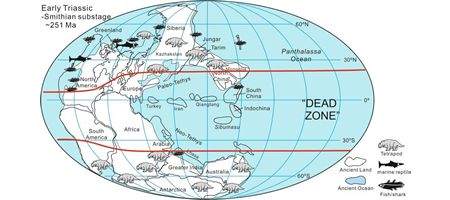Extreme temperatures meant it took five million years for the Earth to recover from the greatest mass extinction of all time.

The end-Permian mass extinction, which occurred around 250 million years ago, wiped out nearly all the world’s species. But while the ‘dead zone’ after most mass extinctions lasts a few tens of thousands of years, this one – during the Early Triassic period – went on for an astonishing five million years.
Now, an international study indicat4es that the reason was a temperature rise to lethal levels in the tropics: around 50-60°C on land, and 40°C at the sea-surface.
“Global warming has long been linked to the end-Permian mass extinction, but this study is the first to show extreme temperatures kept life from re-starting in Equatorial latitudes for millions of years,” says Yadong Sun of the University of Leeds.
It’s also the first study to show that water temperatures close to the ocean’s surface can reach 40°C – a near-lethal value at which marine life dies and photosynthesis stops. Until now, climate modellers have assumed sea-surface temperatures can’t go any higher than 30°C.
While the tropics would have been very wet during the dead zone, there would have been almost nothing growing – no forests, no fish or marine reptiles, and virtually no land animals.
This is despite the fact that, before the end-Permian mass extinction, Earth had teemed with plants and animals including primitive reptiles and amphibians, and a wide variety of sea creatures including coral and sea lilies.
The extreme heat was caused by a breakdown in global carbon cycling. In normal circumstances, plants help regulate temperature by absorbing Co2 and burying it as dead plant matter. Without plants, though,levels of Co2 rose unchecked, causing the temperatures to rocket.
The study, published Oct. 19 in the journal Science, is the most detailed temperature record of this study period (252-247 million years ago) to date.
To establish this, Sun and his colleagues collected data from 15,000 ancient conodonts – the tiny teeth of extinct eel-like fishes – extracted from two tonnes of rocks from South China. Conodonts form a skeleton using oxygen, and the isotopes of oxygen in skeletons are temperature controlled; so by studying the ratio of oxygen isotopes in the conodonts he was able to detect temperature levels hundreds of millions of years ago.
“Nobody has ever dared say that past climates attained these levels of heat,” says
Leeds professor Paul Wignall. “Hopefully future global warming won’t get anywhere near temperatures of 250 million years ago, but if it does we have shown that it may take millions of years to recover.”






